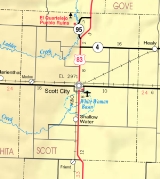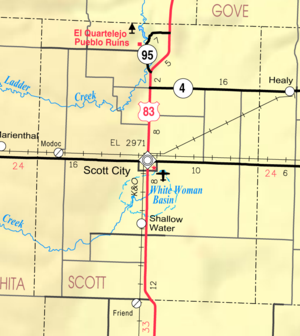
El Quartelejo Ruins
Encyclopedia

Pueblo
Pueblo is a term used to describe modern communities of Native Americans in the Southwestern United States of America. The first Spanish explorers of the Southwest used this term to describe the communities housed in apartment-like structures built of stone, adobe mud, and other local material...
and the only known pueblo in Kansas
Kansas
Kansas is a US state located in the Midwestern United States. It is named after the Kansas River which flows through it, which in turn was named after the Kansa Native American tribe, which inhabited the area. The tribe's name is often said to mean "people of the wind" or "people of the south...
. Located in Lake Scott State Park
Lake Scott State Park
Lake Scott State Park is a Kansas state park in Scott County, Kansas in the United States. The park was established in 1928 following a donation of the land by the Herbert Steele family. The park, also known as Scott State Park, surrounds Lake Scott a spring fed freshwater lake. Lake Scott State...
, the remains of the stone and adobe pueblo are situated north of Scott City, Kansas
Scott City, Kansas
Scott City is a city in and the county seat of Scott County, Kansas, United States. As of the 2010 census, the city population was 3,816.-Geography:Scott City is located at...
, on Ladder Creek
Ladder Creek
Ladder Creek is a stream that flows from a source in Cheyenne County, Colorado to a confluence with the Smoky Hill River in Logan County, Kansas....
.
There are two possibilities for the origin of El Quartelejo. In 1664 a group of Pueblo Indians left New Mexico
New Mexico
New Mexico is a state located in the southwest and western regions of the United States. New Mexico is also usually considered one of the Mountain States. With a population density of 16 per square mile, New Mexico is the sixth-most sparsely inhabited U.S...
and were later rounded up and brought back by the Spanish. They may have constructed El Quartelejo, but more likely is the second possibility. After the collapse of the Pueblo Revolt
Pueblo Revolt
The Pueblo Revolt of 1680, or Popé's Rebellion, was an uprising of several pueblos of the Pueblo people against Spanish colonization of the Americas in the province of Santa Fe de Nuevo México.-Background:...
(1680–1692) most Pueblo Indians accepted the return of Spanish dominion over their lives. A group from the Taos
Taos Pueblo
Taos Pueblo is an ancient pueblo belonging to a Taos speaking Native American tribe of Pueblo people. It is approximately 1000 years old and lies about north of the modern city of Taos, New Mexico, USA...
and Picuris Pueblos, however, did not. In 1696 this group fled New Mexico in search of a new home among the Plains Apache
Plains Apache
The Plains Apache are a Southern Athabaskan group that traditionally live on the Southern Plains of North America and today are centered in Southwestern Oklahoma...
. They moved to the Great Plains
Great Plains
The Great Plains are a broad expanse of flat land, much of it covered in prairie, steppe and grassland, which lies west of the Mississippi River and east of the Rocky Mountains in the United States and Canada. This area covers parts of the U.S...
and evaded the Spanish for ten years. During the years that followed came reports of Frenchmen attempting to trade with the Cuartelejo Apaches. The ill-fated Villazur expedition stopped at El Cuartelejo on its way north to investigate the extent of French influence. Near the forks of the Platte River, the Pawnees killed most of the party, reportedly under French direction. In 1706 they were captured and forced back to New Mexico. When the Pueblo Indians were seized, the Spanish commander, Juan Uribarri, wrote that they were dwelling in houses of a permanent type. The Spanish called this settlement El Quartelejo and the region around it was called San Luis Province.
No Indians lived in El Quartelejo after 1706, but Spanish and French occasionally occupied the structure as a frontier outpost during the 18th century. By the 1730s raids by Comanche, Ute, and Pawnee had decimated the Cuartelejo Apache. The survivors moved south to join the Jicarilla Apache at Pecos. However, after 1763 and the French retreat from the area, the pueblo was abandoned with only a mound and a few irrigation ditches remaining. Eventually, its walls decayed and the structure was buried by drifting soil.
The pueblo was unknown to American explorers, but in 1898 archeologists rediscovered El Quartelejo. Since then, the site has been excavated to reveal that the pueblo was a seven-room structure, enough to house a small band of Indians. Near the pueblo are traces of shallow ditches extending from the nearby springs. These ditches were most likely used to irrigate crops in nearby fields.
Near here in 1878 Col. William H. Lewis commanding troops from Fort Dodge, was fatally wounded in a battle with chief Dull Knife and his Northern Cheyennes. Lewis was the last army officer killed by Indians in Kansas.
In 1964, the El Quartelejo ruins were designated a National Historic Landmark
National Historic Landmark
A National Historic Landmark is a building, site, structure, object, or district, that is officially recognized by the United States government for its historical significance...
, and the area is now part of Lake Scott State Park
Lake Scott State Park
Lake Scott State Park is a Kansas state park in Scott County, Kansas in the United States. The park was established in 1928 following a donation of the land by the Herbert Steele family. The park, also known as Scott State Park, surrounds Lake Scott a spring fed freshwater lake. Lake Scott State...
. The Scott Lake site was developed in 1971 as an interpretive exhibit by Kansas Historical Society archeologists. The outline of the ruins was restored and markers placed for park visitors to see. Since 2004, the National Park Service
National Park Service
The National Park Service is the U.S. federal agency that manages all national parks, many national monuments, and other conservation and historical properties with various title designations...
has listed the El Quartelejo site as "at risk" because of ongoing weather-related deterioration to the ruins.
El Quartelejo Museum in Scott City, Kansas is operated by the Scott County Historical Society. The free museum focuses on local interests, from prehistory to the present day. Temporary exhibits highlight contemporary arts or culture.
The Spanish spelling of El Quartelejo is with a “C”: El Cuartelejo. The English spelling is with a “Q”: El Quartelejo. They are both correct and are used interchangeablely at the museum and the park.

